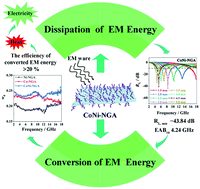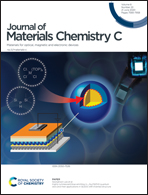General strategy for fabrication of N-doped carbon nanotube/reduced graphene oxide aerogels for dissipation and conversion of electromagnetic energy†
Abstract
Various forms of energy utilization have received a great deal of attention due to excessive fossil fuel consumption and related environmental issues. Electromagnetic energy, considered to be a widespread energy source, can be converted into heat energy and power energy to relieve energy pressure. Herein, we propose a general strategy to fabricate N-doped carbon nanotube/reduced graphene oxide aerogels consisting of metal@graphene core–shell nanoparticles and interconnected N-doped carbon nanotubes. Through this strategy, single-metal (Fe, Co and Ni) and bimetal (CoNi and CoFe)-based aerogels can be successfully fabricated. The as-synthesized aerogels have a density as low as 0.0109 g cm−3. The optimized aerogel displays excellent electromagnetic wave absorption properties when the filler ratio is only 8 wt%. Furthermore, we elucidate the potential of the aerogels in the conversion and utilization of electromagnetic energy. The experimental results demonstrate that the maximal conversion efficiency of the electromagnetic energy is up to 24.56% upon utilization of the optimized aerogel as an absorber. The heat energy converted from electromagnetic energy has potential applications in powering low-power electric devices. Our strategy opens up a possible way to utilize “waste” electromagnetic energy.



 Please wait while we load your content...
Please wait while we load your content...